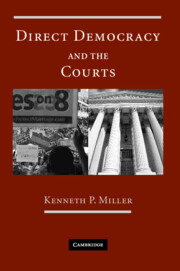Book contents
- Frontmatter
- Contents
- List of Tables and Figures
- Preface
- Introduction: A Clash of Rising Powers
- PART I THE QUEST FOR MAJORITY RULE
- 1 The Epic Debate
- 2 Direct Democracy Gathers Force
- PART II COUNTERING THE MAJORITY
- PART III THE MAJORITY STRIKES BACK
- Conclusion: A New Constitutional Equilibrium
- Appendix: Post-Election Initiative Invalidations
- References
- Index
- References
2 - Direct Democracy Gathers Force
Published online by Cambridge University Press: 05 June 2012
- Frontmatter
- Contents
- List of Tables and Figures
- Preface
- Introduction: A Clash of Rising Powers
- PART I THE QUEST FOR MAJORITY RULE
- 1 The Epic Debate
- 2 Direct Democracy Gathers Force
- PART II COUNTERING THE MAJORITY
- PART III THE MAJORITY STRIKES BACK
- Conclusion: A New Constitutional Equilibrium
- Appendix: Post-Election Initiative Invalidations
- References
- Index
- References
Summary
In 1970, an American Political Science Review article asked, “What ever happened to direct democracy?” By the late 1960s, the initiative process seemed to be moribund in most states and many scholars had come to believe that direct citizen lawmaking, like the horse and buggy, was a relic of history. According to the prevailing view, “[t]he Madisons and Burkes who feared the excesses of democracy may rest in peace.” But, the requiems were, of course, premature. Even as the article circulated, the initiative power was poised to begin a dramatic and sustained resurgence.
This brief story demonstrates direct democracy's resilience. Once embedded in a state's constitutional structure, the process can fall dormant, but later revive. This chapter traces the varying strength of direct citizen lawmaking over time and across states, from its early flourishing in the Progressive Era, through its mid-century decline, to its more recent renewal.
CHANGES IN INITIATIVE USE OVER TIME
Figure 2.1 provides an overview of varying levels of initiative use over time by presenting the total number of statewide initiatives adopted in the twenty-four initiative states, by decade, over the past century.
1900s–1910s: “The Oregon System” and Progressive Era Enthusiasm
Citizens in Oregon adopted twenty-five statewide initiatives between 1904 and 1910 and remained the only voters to enact initiatives until Oklahomans adopted two in 1910.
- Type
- Chapter
- Information
- Direct Democracy and the Courts , pp. 41 - 72Publisher: Cambridge University PressPrint publication year: 2009



